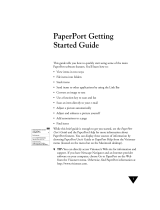
L EGAL NOTICES
Copyright © 1999–2004 by ScanSoft, Inc. All rights reserved. No part of this publication
may be transmitted, transcribed, reproduced, stored in any retrieval system or translated into
any language or computer language in any form or by any means, mechanical, electronic,
magnetic, optical, chemical, manual, or otherwise, without prior written consent from
ScanSoft, Inc., 9 Centennial Drive, Peabody, Massachusetts 01960. Printed in the United
States of America and Ireland.
The software described in this book is furnished under license and may be used or copied only
in accordance with the terms of such license.
I
MPORTANT NOTICE
ScanSoft, Inc. provides this publication “as is” without warranty of any kind, either express or
implied, including but not limited to the implied warranties of merchantability or fitness for a
particular purpose. Some states or jurisdictions do not allow disclaimer of express or implied
warranties in certain transactions; therefore, this statement may not apply to you. ScanSoft
reserves the right to revise this publication and to make changes from time to time in the
content hereof without obligation of ScanSoft to notify any person of such revision or
changes.
T
RADEMARKS AND CREDITS
ScanSoft, PaperPort, ScanDirect, SET, FormTyper, DesktopDelivery, All-in-One Search,
OmniPage and Tr ue Page are registered trademarks or trademarks of ScanSoft, Inc. or its
affiliate companies in the United States of America and/or other countries.
Outside In
®
Viewer Technology © 1992-1999, Word for Word
®
copyright © 1998 Stellent
Chicago, Inc. All rights reserved. The Verity logo is a trademark or registered trademark of
Verity in the United States of America and/or other countries. All other company names or
product names referenced herein may be trademarks of their respective holders.
ScanSoft, Inc.
9 Centennial Drive
Peabody, Massachusetts 01960, U.S.A.
ScanSoft Belgium BVBA
Guldensporenpark 32
BE-9820 Merelbeke, Belgium
PaperPort 10 Getting Started Guide
Part Number 50-F31A-10030
August, 2004

























